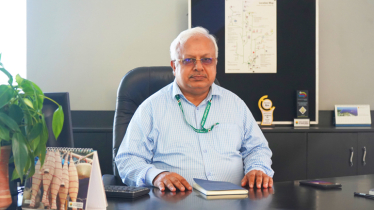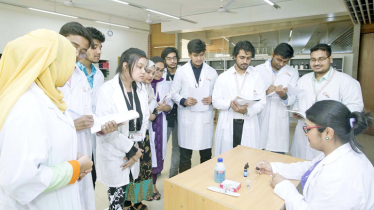
Photo : Messenger
Bangladesh is situated in the delta formed by the Ganges, Brahmaputra, and Meghna rivers. Within the grandeur and resilience of South Asia lies a region that is extremely susceptible to the impacts of climate change. Moreover, this country, renowned for its extensive deltas and densely inhabited coastal areas, faces numerous climate-related challenges, including destructive storms and rising sea levels.
Nevertheless, this geographical positioning renders it particularly prone to the consequences of climate change. The lives and means of sustenance of millions of individuals are imperiled by shifting precipitation patterns, rising sea levels, and catastrophic weather occurrences. Given the challenges at hand, effective climate communication is imperative. In the face of these perils, proficient communication evolves from being merely essential to becoming a critical tool for survival. This paper delves into the crucial significance of improving climate communication in Bangladesh, recognizing inadequacies, and suggesting practical measures to address them.
The detrimental impacts of climate change on a global scale have rendered situations challenging, particularly for emerging and least-developed nations such as Bangladesh. It is widely acknowledged that Bangladesh continues to be a frontrunner in its steadfast endeavors for change, resulting in the mitigation of global harm. However, extensive efforts are ongoing to ensure that environmental apprehensions are integrated into mainstream development strategies to attain both economic progress and environmental sustainability (Economic Review, 2023). Numerous policies and developmental initiatives have been devised and are currently being implemented to address environmental hazards and guarantee a clean and secure environment. Furthermore, a comprehensive action plan has been unveiled to achieve the environmental objectives outlined in the Sustainable Development Goals (SDGs).
Despite being among the country’s most vulnerable to climate change impacts, Bangladesh faces notable challenges in effectively disseminating climate-related information to its populace. Issues such as socioeconomic disparities, low literacy rates, and linguistic diversity exacerbate the situation, leaving numerous communities ill-prepared to confront climate-induced dangers. Additionally, the intricacies of climate science can act as a barrier to comprehension, hindering communication endeavors.
The media plays a significant role in shaping public opinion and discourse on climate-related subjects. Nevertheless, there is a necessity to enhance mainstream media coverage of climate change in Bangladesh. Increased investments are essential to circulate accurate information and climate reports. Furthermore, integrating climate education into educational curricula can equip young individuals with the requisite knowledge and skills to proactively address climate-related challenges. Therefore, it is crucial to provide media professionals with precise climate data and effective communication skills. Collaborative efforts between climate specialists and media entities, along with training initiatives and workshops, can enhance the quality and dissemination of climate-related information, fostering informed public discussions and proactive actions. Likewise, integrating climate education into academic programs can equip future generations with the necessary understanding and competencies to effectively tackle the risks posed by climate change.
Effective communication regarding climate change must be based on local realities and sensitive to the community’s requirements. Dialogue and knowledge exchange can be fostered by involving communities in participatory activities, including seminars, storytelling sessions, and community meetings. In addition, marginalized communities that may have restricted entry to mainstream media can be engaged by utilizing conventional modes of communication such as community radio and theatre. Strengthening communities' capacity to engage actively in climate action can facilitate the development of grassroots resilience and sustainability.
Policy support and government leadership are crucial for advancing climate communication initiatives. Comprehensive climate communication strategies must be developed and implemented at the national level. Additionally, investments in climate-resilient infrastructure and disaster preparedness can strengthen community resilience and mitigate the adverse effects of climate change. Additionally, by cultivating collaborations among private sector entities, government agencies, and civil society organizations, climate communication initiatives can significantly expand in scope and influence. The ‘‘Bangladesh Climate Change Strategy and Action Plan, 2009 (BCCSAP 2009)’’ is being used to deal with the effects of climate change. It includes both activities to adjust to the changes and activities to lessen their impact. This plan listed 44 projects that fit into six main categories. Because of this, the Bangladesh Climate Change Trust Fund (BCCTF) was set up in 2010 with money from the government to fight the effects of climate change and carry out the Bangladesh Climate Change Strategy and Action Plan (BCCSAP) 2009. Every project run by BCCTF is based on one of the themes listed in BCCSAP 2009. A total of Tk. 94.88 crore has been disbursed under this scheme as a refinancing facility from the fund against the bank and FI's loans. This includes ten green products and initiatives, such as a biogas plant, green building, green industry, vermicompost, solar home system, biological ETP, net metering rooftop solar system, installation of energy auditor-certified machines, environment-friendly/brick kiln efficiency improvement project, and safe The 2018 National Environmental Policy As a way to deal with the difficulties of protecting and managing the environment and biodiversity, the Bangladesh Biodiversity Act 2018 and the Environmental Crisis Management Rules 2017 have been made public (Bangladesh Economic Review, 2023).
Technological advancements in the digital age present unparalleled prospects for augmenting climate communication in Bangladesh. Digital innovations can bridge information divides and reach a broad audience, exemplified by interactive online platforms that distribute climate information and mobile applications that provide real-time weather updates. Additionally, by utilizing social media platforms and digital narratives, it is possible to captivate younger demographics and magnify climate-related messages. By applying innovation and technology, we can enable individuals to make well-informed decisions and democratize access to climate information. Technological advancements present promising opportunities for augmenting climate communication in Bangladesh. Utilizing online portals, mobile applications, and social media platforms, climate information can be disseminated to a larger audience, including remote communities. In addition, the utilization of cutting-edge technologies, including virtual reality experiences and data visualization, has the potential to augment the general populace's comprehension of climate effects and strategies for adaptation.
In Bangladesh, the ineffective communication of climate issues is attributable to several obstacles. Particularly in rural regions, restricted access to education and information impedes comprehension and awareness of climate change. Moreover, the obstacle of linguistic diversity hinders the effective distribution of information to diverse ethnic communities throughout the nation. Furthermore, the significance of climate communication in policy agendas is frequently eclipsed by the politicization of climate discourse and competing development priorities. Along with protecting the ozone layer and reducing pollution, the Ministry of Environment, Forest, and Climate Change has also run some programs to raise awareness and reorganize actions to protect the environment. The Ministries of Disaster Management and Relief and the Ministries of Water Resources also run different schemes and projects to deal with problems that may arise after natural disasters (Economic Review, 2023).
Improving climate communication in Bangladesh is a critical survival necessity, not merely a strategic consideration. By integrating technological innovation, government collaboration, community participation, media engagement, and education, we can enable communities and individuals to become catalysts for transformation amidst climate uncertainty. As we confront the intricate challenges of climate change, we all remain steadfast in our dedication to improving climate communication and constructing a resilient and sustainable future for future generations. Moreover, it is crucial for Bangladesh’s resilience to climate change and sustainable development that there is a reconciliation in climate communication. By leveraging technology and innovation and empowering media professionals, educators, communities, and policymakers, it is possible to improve climate communication endeavors and construct a nation that is more resilient to climate change. In confronting the complexities of climate change, we must forge a unified front in our dedication to proficient communication, heightened consciousness, and collaborative efforts to secure Bangladesh’s long-term sustainability.
Mamunor Rashid, Associate Professor, Khulna University, Bangladesh & Graduate Teaching Assistant, University of Southern Mississippi, USA
Messenger/Disha








